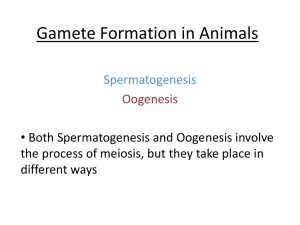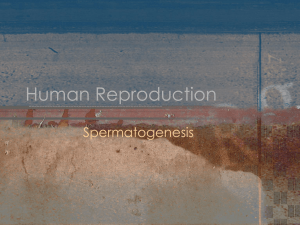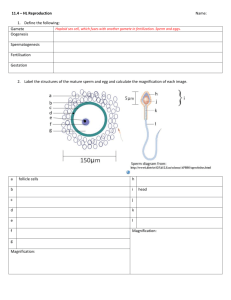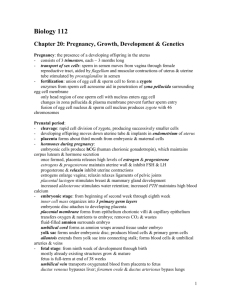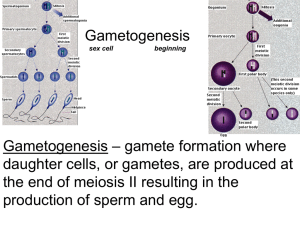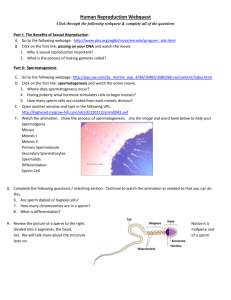HL Topic 11.4 Reproduction
advertisement
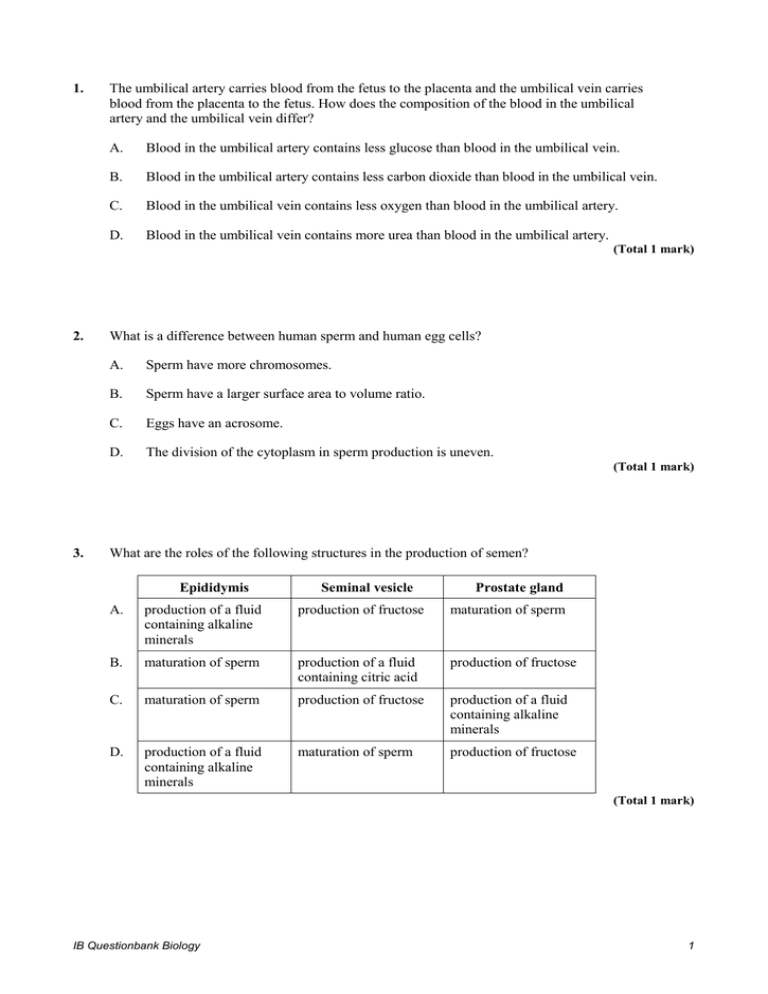
1. The umbilical artery carries blood from the fetus to the placenta and the umbilical vein carries blood from the placenta to the fetus. How does the composition of the blood in the umbilical artery and the umbilical vein differ? A. Blood in the umbilical artery contains less glucose than blood in the umbilical vein. B. Blood in the umbilical artery contains less carbon dioxide than blood in the umbilical vein. C. Blood in the umbilical vein contains less oxygen than blood in the umbilical artery. D. Blood in the umbilical vein contains more urea than blood in the umbilical artery. (Total 1 mark) 2. What is a difference between human sperm and human egg cells? A. Sperm have more chromosomes. B. Sperm have a larger surface area to volume ratio. C. Eggs have an acrosome. D. The division of the cytoplasm in sperm production is uneven. (Total 1 mark) 3. What are the roles of the following structures in the production of semen? Epididymis Seminal vesicle Prostate gland A. production of a fluid containing alkaline minerals production of fructose maturation of sperm B. maturation of sperm production of a fluid containing citric acid production of fructose C. maturation of sperm production of fructose production of a fluid containing alkaline minerals D. production of a fluid containing alkaline minerals maturation of sperm production of fructose (Total 1 mark) IB Questionbank Biology 1 4. What is the role of HCG in early pregnancy? A. It prevents the degeneration of the corpus luteum. B. It initiates the development of the uterus lining. C. It inhibits the production of estrogen. D. It stimulates the degeneration of the corpus luteum. (Total 1 mark) 5. Which pair of statements best describes oogenesis and spermatogenesis? Oogenesis Spermatogenesis A. Four eggs are produced per mitosis every 28 days Millions of sperms are produced per mitosis B. Four eggs are produced per meiosis every 28 days One sperm is produced per meiosis C. One egg is produced per mitosis every 28 days Millions of sperms are produced per meiosis D. One egg is produced per meiosis every 28 days Four sperms are produced per meiosis (Total 1 mark) 6. What is the role of FSH in spermatogenesis? A. It stimulates the secretion of testosterone from the Sertoli cells. B. It inhibits the secretion of testosterone from the interstitial cells. C. It stimulates the action of testosterone on the Sertoli cells. D. It stimulates the secretion of LH from the pituitary cells. (Total 1 mark) IB Questionbank Biology 2 7. What is the difference between spermatogenesis and oogenesis? Spermatogenesis Oogenesis A. final cells are a similar size final cells are not all the same size B. cells produced are undifferentiated cells produced are differentiated C. spermatogenesis begins in a boy at birth oogenesis begins in a girl before she is born D. one germinal epithelium cell produces four sperm cells in a testis one germinal epithelium cell produces one oocyte in the ovary (Total 1 mark) 8. What is the function of the tRNA activating enzyme? A. It links tRNA to ribosomes. B. It links tRNA to mRNA. C. It links tRNA to a specific amino acid. D. It links an amino acid on one tRNA to an amino acid on another tRNA. (Total 1 mark) 9. What is the role of testosterone in spermatogenesis? A. It stimulates interstitial cells. B. It stimulates Sertoli cells. C. It inhibits the germinal epithelium. D. It inhibits the prostate gland. (Total 1 mark) IB Questionbank Biology 3 10. What is the role of HCG in early pregnancy? A. HCG stimulates FSH secretions. B. HCG stimulates the degeneration of the corpus luteum. C. HCG stimulates ovarian estrogen and progesterone secretion. D. HCG stimulates uterine contractions. (Total 1 mark) 11. Which of the cells labelled in the diagram below provides nourishment for developing sperm cells? [Source: Freeman & Bracegirdle, An Atlas of Histology, (Heinemann: 1976) p. 91, Copyright holder unknown.] (Total 1 mark) IB Questionbank Biology 4 12. The diagram below shows a human egg. What are the structures labelled I, II and III? I II III A. acrosomes zona pellucida follicle cells B. acrosomes cell wall sperm C. cortical granules cell wall sperm D. cortical granules zona pellucida follicle cells (Total 1 mark) 13. (a) Outline a possible cause of Down syndrome. (4) (b) Outline the processes involved in oogenesis within the human ovary. (8) (c) Discuss the ethical issues surrounding IVF. (6) (Total 18 marks) IB Questionbank Biology 5 14. Up to two additional marks are available for the construction of your answers. (2) (a) Draw a labelled diagram of the adult female reproductive system. (4) (b) Outline the roles of progesterone and estrogen in the human menstrual cycle. (6) (c) Explain the function and structure of the placenta. (8) (Total 20 marks) IB Questionbank Biology 6

